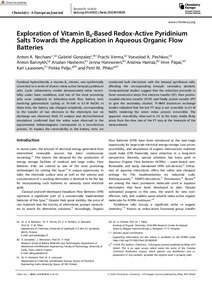Exploration of Vitamin B6-Based Redox-Active Pyridinium Salts towards the Application in Aqueous Organic Flow Batteries
Nechaev Anton A.; Gonzalez Gabriel; Verma Prachi; Peshkov Vsevolod A.; Bannykh Anton; Hashemi Arsalan; Hannonen Jenna; Hamza Andrea; Papai Imre; Laasonen Kari; Peljo Pekka; Pihko Petri M.
Exploration of Vitamin B6-Based Redox-Active Pyridinium Salts towards the Application in Aqueous Organic Flow Batteries
Nechaev Anton A.
Gonzalez Gabriel
Verma Prachi
Peshkov Vsevolod A.
Bannykh Anton
Hashemi Arsalan
Hannonen Jenna
Hamza Andrea
Papai Imre
Laasonen Kari
Peljo Pekka
Pihko Petri M.
Wiley-VCH
Julkaisun pysyvä osoite on:
https://urn.fi/URN:NBN:fi-fe2025082788272
https://urn.fi/URN:NBN:fi-fe2025082788272
Tiivistelmä
Pyridoxal hydrochloride, a vitamin B6 vitamer, was synthetically converted to a series of diverse redox-active benzoyl pyridinium salts. Cyclic voltammetry studies demonstrated redox reversibility under basic conditions, and two of the most promising salts were subjected to laboratory-scale redox flow battery tests involving galvanostatic cycling at 10 mM in 0.1 M NaOH. In these tests, the battery was charged completely, corresponding to the transfer of two electrons to the electrolyte, but no discharge was observed. Both CV analysis and electrochemical simulations confirmed that the redox wave observed in the experimental voltammograms corresponds to a two-electron process. To explain the irreversibility in the battery tests, we conducted bulk electrolysis with the benzoyl pyridinium salts, affording the corresponding benzylic secondary alcohols. Computational studies suggest that the reduction proceeds in three consecutive steps: first electron transfer (ET), then proton-coupled electron transfer (PCET) and finally proton transfer (PT) to give the secondary alcohol. 1H NMR deuterium exchange studies indicated that the last PT step is not reversible in 0.1 M NaOH, rendering the entire redox process irreversible. The apparent reversibility observed in CV at the basic media likely arises from the slow rate of the PT step at the timescale of the measurement.
Kokoelmat
- Rinnakkaistallenteet [27094]
